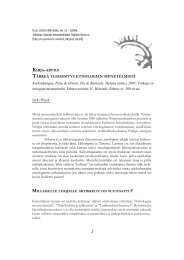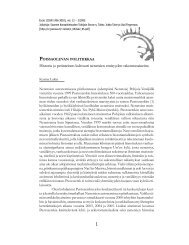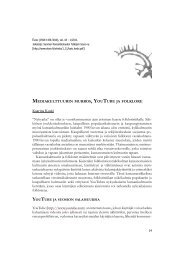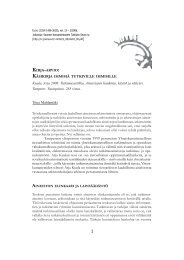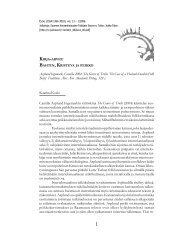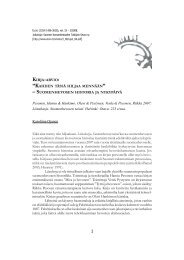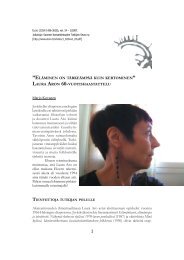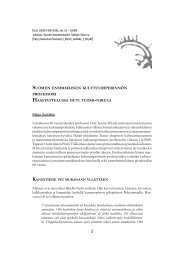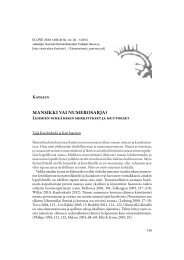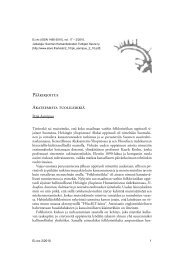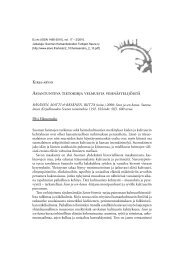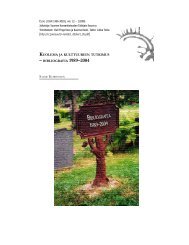Muutoksen tuulia - Elore
Muutoksen tuulia - Elore
Muutoksen tuulia - Elore
You also want an ePaper? Increase the reach of your titles
YUMPU automatically turns print PDFs into web optimized ePapers that Google loves.
Frog: Legends in Culture – Culture in Legends<br />
Accessibility<br />
Indices are research tools. The hierarchical organization of TSFL according to 24<br />
thematic categories equips the index first for investigation of these nexuses of belief<br />
traditions, how they are connected to narrative plots and their distribution. The narrative<br />
plots being indexed are at the bottom of the hierarchy, making it unavoidable<br />
that some plot-types are multiply indexed, but this is potentially inevitable in any<br />
hierarchically organized indexing system and even occurs in the ATU tale-type index<br />
(cf. Dundes 1962, 98–99). This is accommodated by cross-referencing individual<br />
relevant plot-types under each entry. Founding the typology on vernacular categories<br />
made it unnecessary to align the coding of categories with those of other indices (e.g.<br />
“Giants” = TSFL’s J, Simonsuuri’s N, Thompson’s G) or to conform its representation<br />
of the tradition to externally generated ideals. This more accurate rendering of<br />
the vernacular tradition is not without compromise. As a culture-specific indexing<br />
system, other legend traditions cannot be integrated into the TSFL type-system nor<br />
can the type-system be applied to other cultures without reassigning the principle<br />
vernacular categories and building anew on that foundation. Publishing the index in<br />
English orients it to a foreign, international audience, for whom the unique system<br />
will be unfamiliar. The international accessibility sacrificed to a unique, but more<br />
accurate culture-specific indexing system could have been accommodated by better<br />
indexing, particularly where TSFL is less well equipped for investigating elements<br />
of the tradition that are outside of its main thematic categories and not identical<br />
to plot-types (e.g. motifs). The keyword index helps a reader find relevant material,<br />
but it is not very sophisticated for navigating more than 1,800 types distributed over<br />
436 pages, and seems limited by priorities (e.g. prehistoric kings such as Håkon Ring<br />
in W121 and Ragnar Lodbrok in X2 are not indexed). Other type-systems are well<br />
cross-referenced in TSFL’s apparatus for each plot-type entry, but only the ATU<br />
tale-type correspondences are listed at the back of the volume. Lists of other crossreferences<br />
would have made TSFL more practically accessible to a range of scholars<br />
approaching Swedish legends from diverse perspectives. A motif-index would be a<br />
welcome future supplement.<br />
An Exciting Resource<br />
The wealth and diversity of information in TSFL makes it a valuable resource and<br />
opens many research possibilities. Framing regional variation in relation to social<br />
realities and interactions between beliefs and real-world phenomena is both vitally<br />
informative to an unfamiliar reader and also provides foundations for future investigations.<br />
The structure of TSFL invites analysis of the impact of different categories<br />
of adversary or mythic being on stable plot-types as well as of the intersection of<br />
narrative plot, belief tradition and cultural environments as a social process. Plot<br />
summaries highlight certain expressions that index a mythic being as the speaker,<br />
<strong>Elore</strong> 1/2012 135



